Monopoly and Monopolistic Competition in Australian Industry
VerifiedAdded on 2023/06/03
|11
|2863
|101
AI Summary
This article discusses the different market structures in Australia, including monopoly and monopolistic competition, and explains why government intervention is necessary for monopolies but not for firms operating in a monopolistically competitive industrial structure.
Contribute Materials
Your contribution can guide someone’s learning journey. Share your
documents today.

Running head: ECONOMICS ASSIGNMENT
Economics Assignment
Name of the Student:
Name of the University:
Author’s Note:
Economics Assignment
Name of the Student:
Name of the University:
Author’s Note:
Secure Best Marks with AI Grader
Need help grading? Try our AI Grader for instant feedback on your assignments.
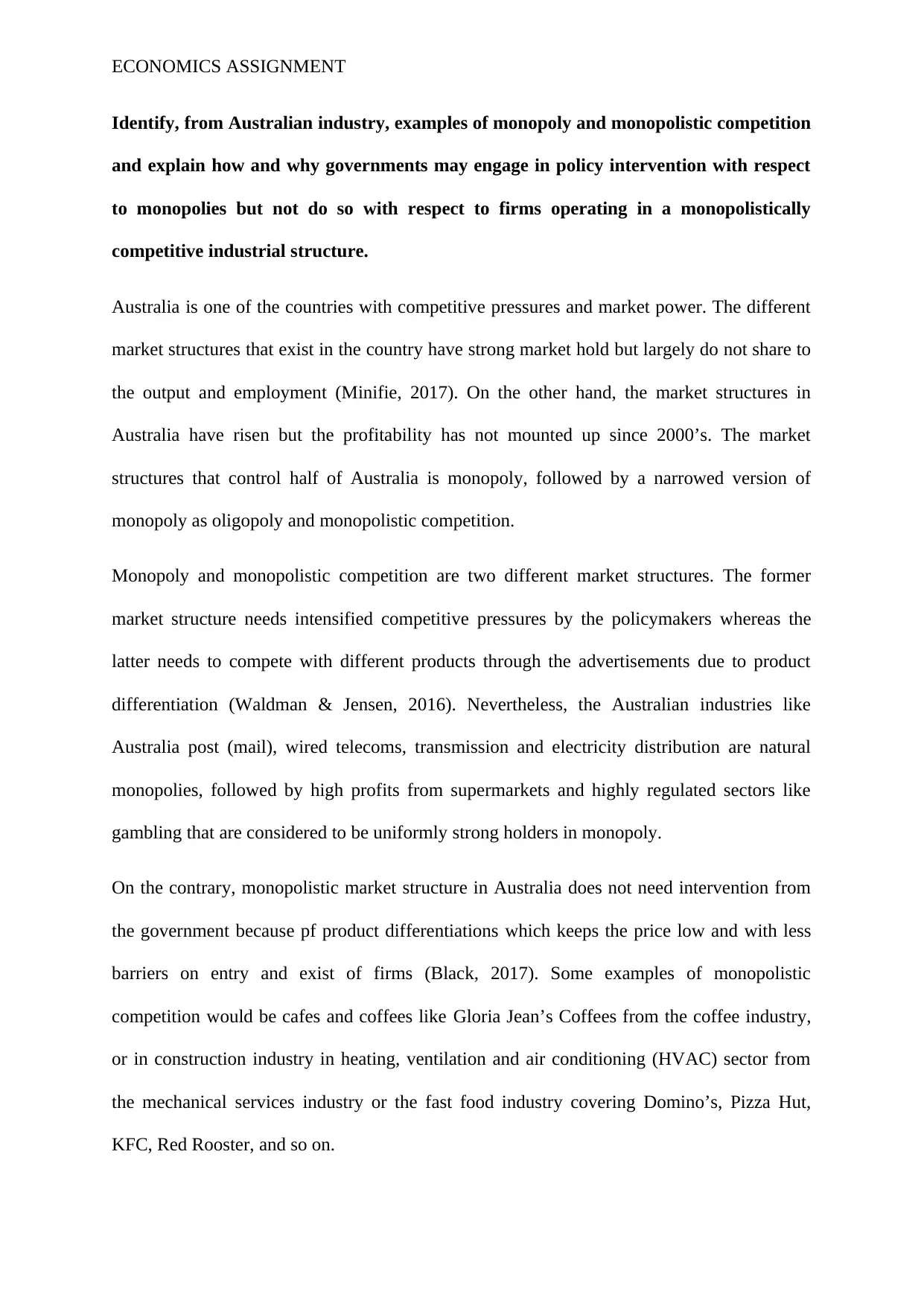
ECONOMICS ASSIGNMENT
Identify, from Australian industry, examples of monopoly and monopolistic competition
and explain how and why governments may engage in policy intervention with respect
to monopolies but not do so with respect to firms operating in a monopolistically
competitive industrial structure.
Australia is one of the countries with competitive pressures and market power. The different
market structures that exist in the country have strong market hold but largely do not share to
the output and employment (Minifie, 2017). On the other hand, the market structures in
Australia have risen but the profitability has not mounted up since 2000’s. The market
structures that control half of Australia is monopoly, followed by a narrowed version of
monopoly as oligopoly and monopolistic competition.
Monopoly and monopolistic competition are two different market structures. The former
market structure needs intensified competitive pressures by the policymakers whereas the
latter needs to compete with different products through the advertisements due to product
differentiation (Waldman & Jensen, 2016). Nevertheless, the Australian industries like
Australia post (mail), wired telecoms, transmission and electricity distribution are natural
monopolies, followed by high profits from supermarkets and highly regulated sectors like
gambling that are considered to be uniformly strong holders in monopoly.
On the contrary, monopolistic market structure in Australia does not need intervention from
the government because pf product differentiations which keeps the price low and with less
barriers on entry and exist of firms (Black, 2017). Some examples of monopolistic
competition would be cafes and coffees like Gloria Jean’s Coffees from the coffee industry,
or in construction industry in heating, ventilation and air conditioning (HVAC) sector from
the mechanical services industry or the fast food industry covering Domino’s, Pizza Hut,
KFC, Red Rooster, and so on.
Identify, from Australian industry, examples of monopoly and monopolistic competition
and explain how and why governments may engage in policy intervention with respect
to monopolies but not do so with respect to firms operating in a monopolistically
competitive industrial structure.
Australia is one of the countries with competitive pressures and market power. The different
market structures that exist in the country have strong market hold but largely do not share to
the output and employment (Minifie, 2017). On the other hand, the market structures in
Australia have risen but the profitability has not mounted up since 2000’s. The market
structures that control half of Australia is monopoly, followed by a narrowed version of
monopoly as oligopoly and monopolistic competition.
Monopoly and monopolistic competition are two different market structures. The former
market structure needs intensified competitive pressures by the policymakers whereas the
latter needs to compete with different products through the advertisements due to product
differentiation (Waldman & Jensen, 2016). Nevertheless, the Australian industries like
Australia post (mail), wired telecoms, transmission and electricity distribution are natural
monopolies, followed by high profits from supermarkets and highly regulated sectors like
gambling that are considered to be uniformly strong holders in monopoly.
On the contrary, monopolistic market structure in Australia does not need intervention from
the government because pf product differentiations which keeps the price low and with less
barriers on entry and exist of firms (Black, 2017). Some examples of monopolistic
competition would be cafes and coffees like Gloria Jean’s Coffees from the coffee industry,
or in construction industry in heating, ventilation and air conditioning (HVAC) sector from
the mechanical services industry or the fast food industry covering Domino’s, Pizza Hut,
KFC, Red Rooster, and so on.
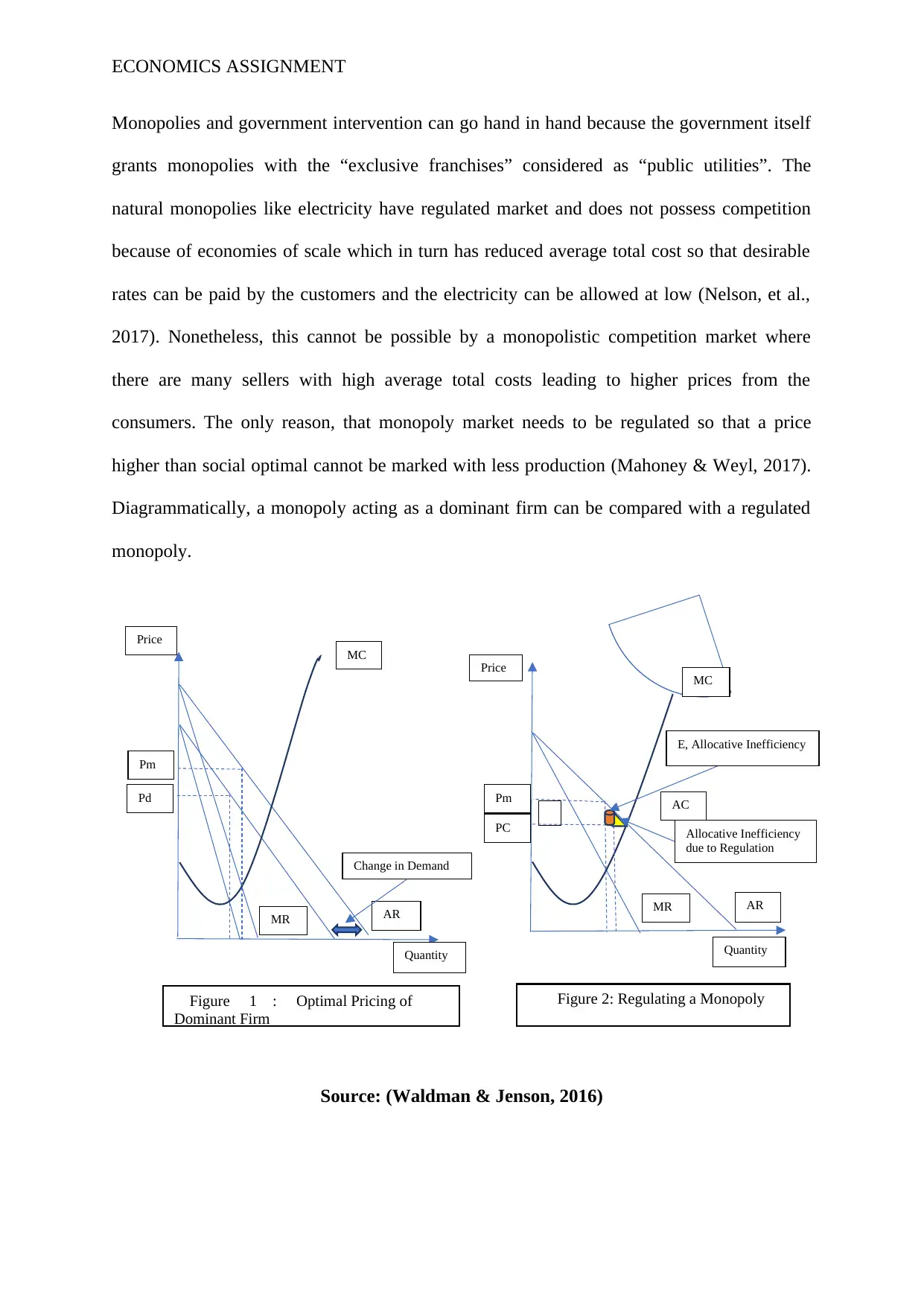
MC
MC
Price
Price
Pm
AR
ARMR
MR
Quantity Quantity
Figure 2: Regulating a MonopolyFigure 1 : Optimal Pricing of
Dominant Firm
E, Allocative Inefficiency
Allocative Inefficiency
due to Regulation
AC
Pm
Pd
Change in Demand
PC
ECONOMICS ASSIGNMENT
Monopolies and government intervention can go hand in hand because the government itself
grants monopolies with the “exclusive franchises” considered as “public utilities”. The
natural monopolies like electricity have regulated market and does not possess competition
because of economies of scale which in turn has reduced average total cost so that desirable
rates can be paid by the customers and the electricity can be allowed at low (Nelson, et al.,
2017). Nonetheless, this cannot be possible by a monopolistic competition market where
there are many sellers with high average total costs leading to higher prices from the
consumers. The only reason, that monopoly market needs to be regulated so that a price
higher than social optimal cannot be marked with less production (Mahoney & Weyl, 2017).
Diagrammatically, a monopoly acting as a dominant firm can be compared with a regulated
monopoly.
Source: (Waldman & Jenson, 2016)
MC
Price
Price
Pm
AR
ARMR
MR
Quantity Quantity
Figure 2: Regulating a MonopolyFigure 1 : Optimal Pricing of
Dominant Firm
E, Allocative Inefficiency
Allocative Inefficiency
due to Regulation
AC
Pm
Pd
Change in Demand
PC
ECONOMICS ASSIGNMENT
Monopolies and government intervention can go hand in hand because the government itself
grants monopolies with the “exclusive franchises” considered as “public utilities”. The
natural monopolies like electricity have regulated market and does not possess competition
because of economies of scale which in turn has reduced average total cost so that desirable
rates can be paid by the customers and the electricity can be allowed at low (Nelson, et al.,
2017). Nonetheless, this cannot be possible by a monopolistic competition market where
there are many sellers with high average total costs leading to higher prices from the
consumers. The only reason, that monopoly market needs to be regulated so that a price
higher than social optimal cannot be marked with less production (Mahoney & Weyl, 2017).
Diagrammatically, a monopoly acting as a dominant firm can be compared with a regulated
monopoly.
Source: (Waldman & Jenson, 2016)
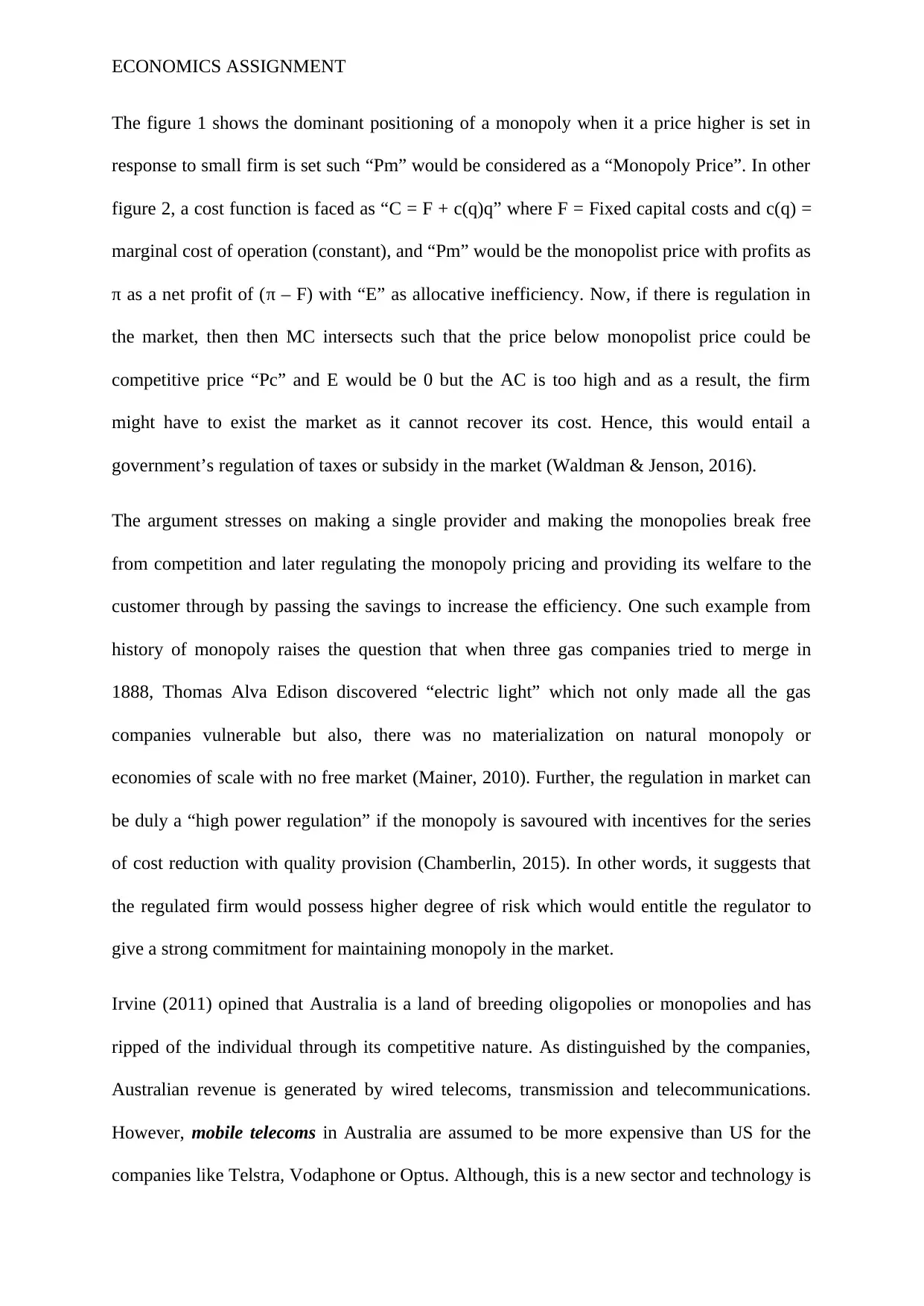
ECONOMICS ASSIGNMENT
The figure 1 shows the dominant positioning of a monopoly when it a price higher is set in
response to small firm is set such “Pm” would be considered as a “Monopoly Price”. In other
figure 2, a cost function is faced as “C = F + c(q)q” where F = Fixed capital costs and c(q) =
marginal cost of operation (constant), and “Pm” would be the monopolist price with profits as
π as a net profit of (π – F) with “E” as allocative inefficiency. Now, if there is regulation in
the market, then then MC intersects such that the price below monopolist price could be
competitive price “Pc” and E would be 0 but the AC is too high and as a result, the firm
might have to exist the market as it cannot recover its cost. Hence, this would entail a
government’s regulation of taxes or subsidy in the market (Waldman & Jenson, 2016).
The argument stresses on making a single provider and making the monopolies break free
from competition and later regulating the monopoly pricing and providing its welfare to the
customer through by passing the savings to increase the efficiency. One such example from
history of monopoly raises the question that when three gas companies tried to merge in
1888, Thomas Alva Edison discovered “electric light” which not only made all the gas
companies vulnerable but also, there was no materialization on natural monopoly or
economies of scale with no free market (Mainer, 2010). Further, the regulation in market can
be duly a “high power regulation” if the monopoly is savoured with incentives for the series
of cost reduction with quality provision (Chamberlin, 2015). In other words, it suggests that
the regulated firm would possess higher degree of risk which would entitle the regulator to
give a strong commitment for maintaining monopoly in the market.
Irvine (2011) opined that Australia is a land of breeding oligopolies or monopolies and has
ripped of the individual through its competitive nature. As distinguished by the companies,
Australian revenue is generated by wired telecoms, transmission and telecommunications.
However, mobile telecoms in Australia are assumed to be more expensive than US for the
companies like Telstra, Vodaphone or Optus. Although, this is a new sector and technology is
The figure 1 shows the dominant positioning of a monopoly when it a price higher is set in
response to small firm is set such “Pm” would be considered as a “Monopoly Price”. In other
figure 2, a cost function is faced as “C = F + c(q)q” where F = Fixed capital costs and c(q) =
marginal cost of operation (constant), and “Pm” would be the monopolist price with profits as
π as a net profit of (π – F) with “E” as allocative inefficiency. Now, if there is regulation in
the market, then then MC intersects such that the price below monopolist price could be
competitive price “Pc” and E would be 0 but the AC is too high and as a result, the firm
might have to exist the market as it cannot recover its cost. Hence, this would entail a
government’s regulation of taxes or subsidy in the market (Waldman & Jenson, 2016).
The argument stresses on making a single provider and making the monopolies break free
from competition and later regulating the monopoly pricing and providing its welfare to the
customer through by passing the savings to increase the efficiency. One such example from
history of monopoly raises the question that when three gas companies tried to merge in
1888, Thomas Alva Edison discovered “electric light” which not only made all the gas
companies vulnerable but also, there was no materialization on natural monopoly or
economies of scale with no free market (Mainer, 2010). Further, the regulation in market can
be duly a “high power regulation” if the monopoly is savoured with incentives for the series
of cost reduction with quality provision (Chamberlin, 2015). In other words, it suggests that
the regulated firm would possess higher degree of risk which would entitle the regulator to
give a strong commitment for maintaining monopoly in the market.
Irvine (2011) opined that Australia is a land of breeding oligopolies or monopolies and has
ripped of the individual through its competitive nature. As distinguished by the companies,
Australian revenue is generated by wired telecoms, transmission and telecommunications.
However, mobile telecoms in Australia are assumed to be more expensive than US for the
companies like Telstra, Vodaphone or Optus. Although, this is a new sector and technology is
Secure Best Marks with AI Grader
Need help grading? Try our AI Grader for instant feedback on your assignments.
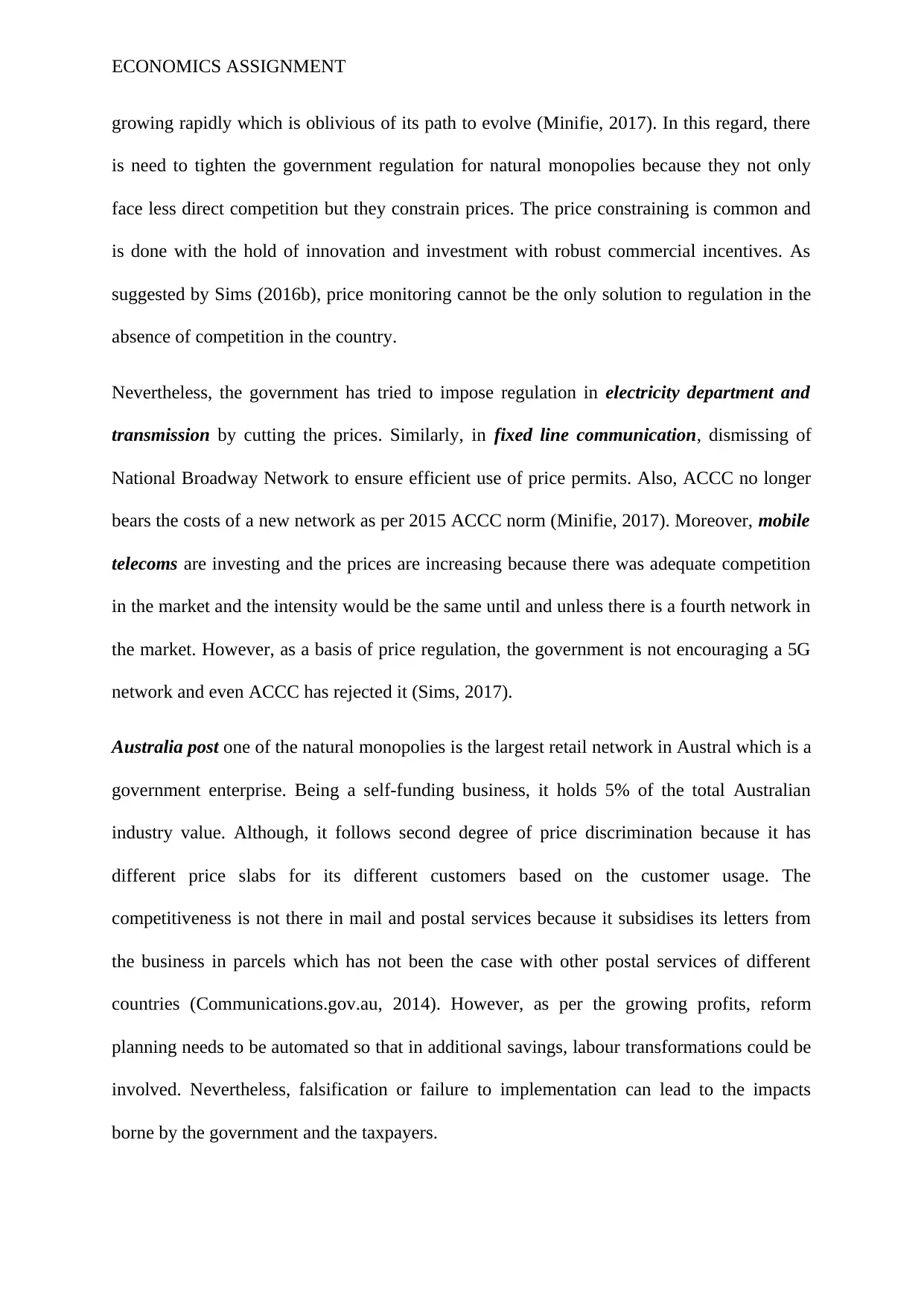
ECONOMICS ASSIGNMENT
growing rapidly which is oblivious of its path to evolve (Minifie, 2017). In this regard, there
is need to tighten the government regulation for natural monopolies because they not only
face less direct competition but they constrain prices. The price constraining is common and
is done with the hold of innovation and investment with robust commercial incentives. As
suggested by Sims (2016b), price monitoring cannot be the only solution to regulation in the
absence of competition in the country.
Nevertheless, the government has tried to impose regulation in electricity department and
transmission by cutting the prices. Similarly, in fixed line communication, dismissing of
National Broadway Network to ensure efficient use of price permits. Also, ACCC no longer
bears the costs of a new network as per 2015 ACCC norm (Minifie, 2017). Moreover, mobile
telecoms are investing and the prices are increasing because there was adequate competition
in the market and the intensity would be the same until and unless there is a fourth network in
the market. However, as a basis of price regulation, the government is not encouraging a 5G
network and even ACCC has rejected it (Sims, 2017).
Australia post one of the natural monopolies is the largest retail network in Austral which is a
government enterprise. Being a self-funding business, it holds 5% of the total Australian
industry value. Although, it follows second degree of price discrimination because it has
different price slabs for its different customers based on the customer usage. The
competitiveness is not there in mail and postal services because it subsidises its letters from
the business in parcels which has not been the case with other postal services of different
countries (Communications.gov.au, 2014). However, as per the growing profits, reform
planning needs to be automated so that in additional savings, labour transformations could be
involved. Nevertheless, falsification or failure to implementation can lead to the impacts
borne by the government and the taxpayers.
growing rapidly which is oblivious of its path to evolve (Minifie, 2017). In this regard, there
is need to tighten the government regulation for natural monopolies because they not only
face less direct competition but they constrain prices. The price constraining is common and
is done with the hold of innovation and investment with robust commercial incentives. As
suggested by Sims (2016b), price monitoring cannot be the only solution to regulation in the
absence of competition in the country.
Nevertheless, the government has tried to impose regulation in electricity department and
transmission by cutting the prices. Similarly, in fixed line communication, dismissing of
National Broadway Network to ensure efficient use of price permits. Also, ACCC no longer
bears the costs of a new network as per 2015 ACCC norm (Minifie, 2017). Moreover, mobile
telecoms are investing and the prices are increasing because there was adequate competition
in the market and the intensity would be the same until and unless there is a fourth network in
the market. However, as a basis of price regulation, the government is not encouraging a 5G
network and even ACCC has rejected it (Sims, 2017).
Australia post one of the natural monopolies is the largest retail network in Austral which is a
government enterprise. Being a self-funding business, it holds 5% of the total Australian
industry value. Although, it follows second degree of price discrimination because it has
different price slabs for its different customers based on the customer usage. The
competitiveness is not there in mail and postal services because it subsidises its letters from
the business in parcels which has not been the case with other postal services of different
countries (Communications.gov.au, 2014). However, as per the growing profits, reform
planning needs to be automated so that in additional savings, labour transformations could be
involved. Nevertheless, falsification or failure to implementation can lead to the impacts
borne by the government and the taxpayers.
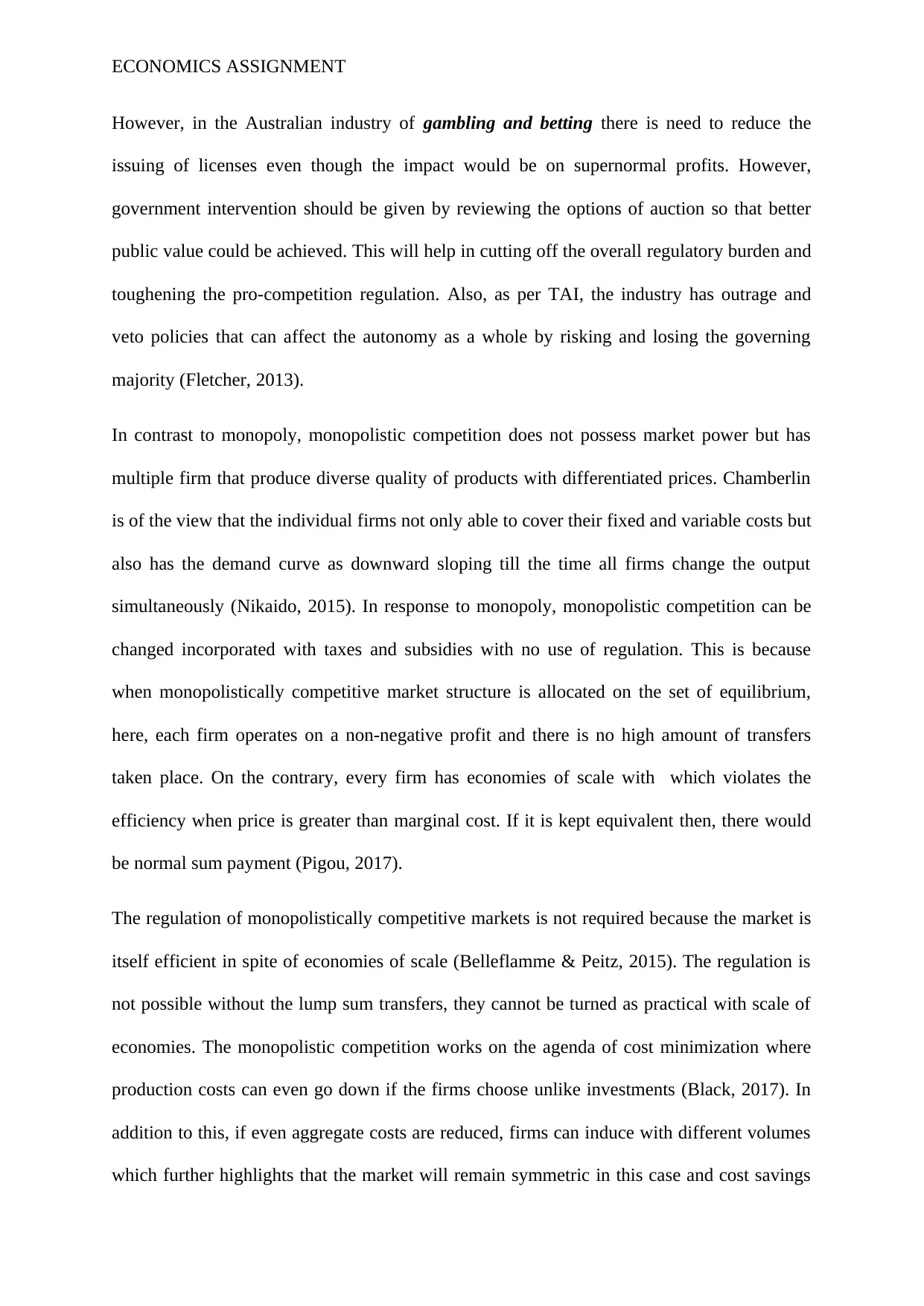
ECONOMICS ASSIGNMENT
However, in the Australian industry of gambling and betting there is need to reduce the
issuing of licenses even though the impact would be on supernormal profits. However,
government intervention should be given by reviewing the options of auction so that better
public value could be achieved. This will help in cutting off the overall regulatory burden and
toughening the pro-competition regulation. Also, as per TAI, the industry has outrage and
veto policies that can affect the autonomy as a whole by risking and losing the governing
majority (Fletcher, 2013).
In contrast to monopoly, monopolistic competition does not possess market power but has
multiple firm that produce diverse quality of products with differentiated prices. Chamberlin
is of the view that the individual firms not only able to cover their fixed and variable costs but
also has the demand curve as downward sloping till the time all firms change the output
simultaneously (Nikaido, 2015). In response to monopoly, monopolistic competition can be
changed incorporated with taxes and subsidies with no use of regulation. This is because
when monopolistically competitive market structure is allocated on the set of equilibrium,
here, each firm operates on a non-negative profit and there is no high amount of transfers
taken place. On the contrary, every firm has economies of scale with which violates the
efficiency when price is greater than marginal cost. If it is kept equivalent then, there would
be normal sum payment (Pigou, 2017).
The regulation of monopolistically competitive markets is not required because the market is
itself efficient in spite of economies of scale (Belleflamme & Peitz, 2015). The regulation is
not possible without the lump sum transfers, they cannot be turned as practical with scale of
economies. The monopolistic competition works on the agenda of cost minimization where
production costs can even go down if the firms choose unlike investments (Black, 2017). In
addition to this, if even aggregate costs are reduced, firms can induce with different volumes
which further highlights that the market will remain symmetric in this case and cost savings
However, in the Australian industry of gambling and betting there is need to reduce the
issuing of licenses even though the impact would be on supernormal profits. However,
government intervention should be given by reviewing the options of auction so that better
public value could be achieved. This will help in cutting off the overall regulatory burden and
toughening the pro-competition regulation. Also, as per TAI, the industry has outrage and
veto policies that can affect the autonomy as a whole by risking and losing the governing
majority (Fletcher, 2013).
In contrast to monopoly, monopolistic competition does not possess market power but has
multiple firm that produce diverse quality of products with differentiated prices. Chamberlin
is of the view that the individual firms not only able to cover their fixed and variable costs but
also has the demand curve as downward sloping till the time all firms change the output
simultaneously (Nikaido, 2015). In response to monopoly, monopolistic competition can be
changed incorporated with taxes and subsidies with no use of regulation. This is because
when monopolistically competitive market structure is allocated on the set of equilibrium,
here, each firm operates on a non-negative profit and there is no high amount of transfers
taken place. On the contrary, every firm has economies of scale with which violates the
efficiency when price is greater than marginal cost. If it is kept equivalent then, there would
be normal sum payment (Pigou, 2017).
The regulation of monopolistically competitive markets is not required because the market is
itself efficient in spite of economies of scale (Belleflamme & Peitz, 2015). The regulation is
not possible without the lump sum transfers, they cannot be turned as practical with scale of
economies. The monopolistic competition works on the agenda of cost minimization where
production costs can even go down if the firms choose unlike investments (Black, 2017). In
addition to this, if even aggregate costs are reduced, firms can induce with different volumes
which further highlights that the market will remain symmetric in this case and cost savings
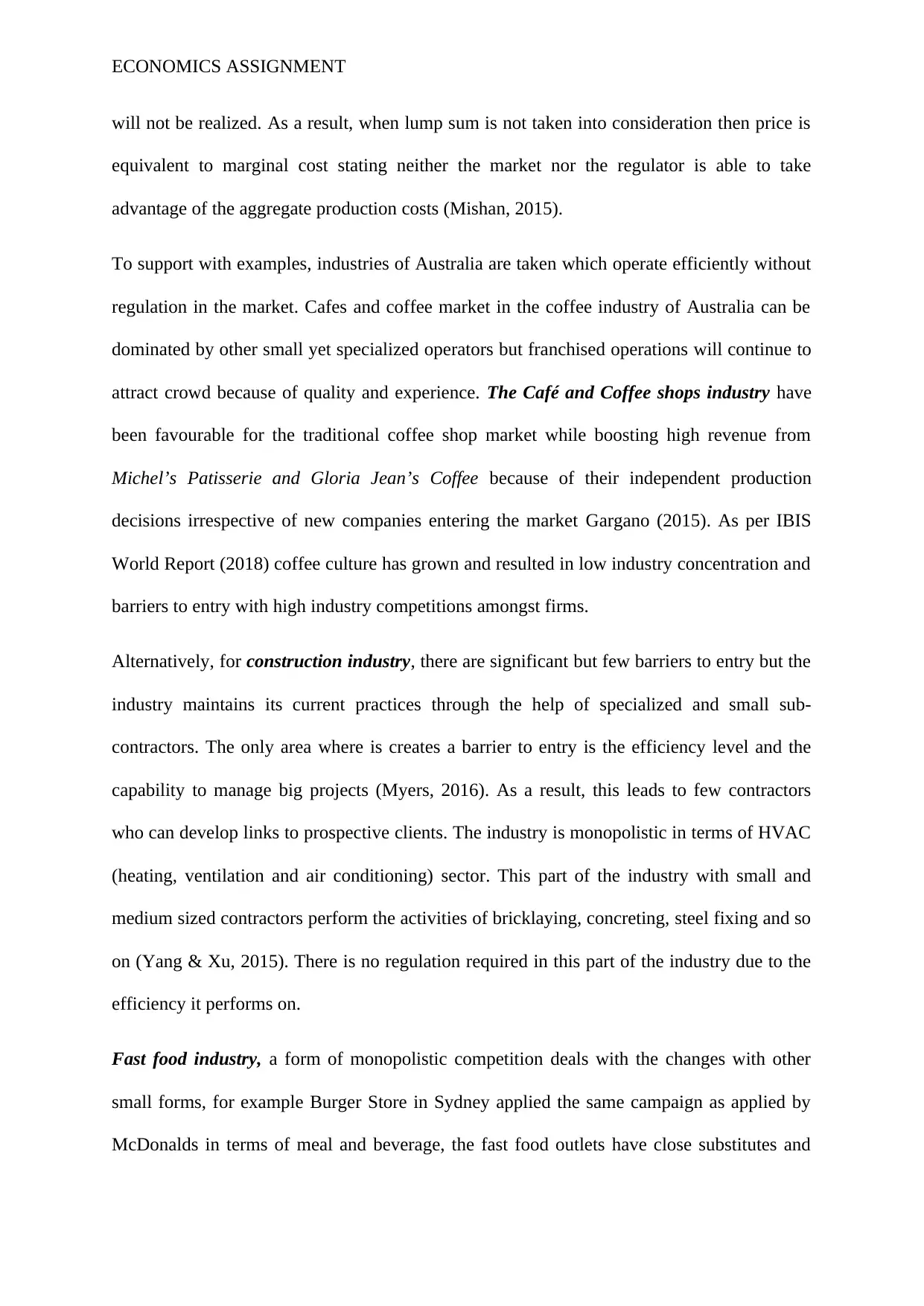
ECONOMICS ASSIGNMENT
will not be realized. As a result, when lump sum is not taken into consideration then price is
equivalent to marginal cost stating neither the market nor the regulator is able to take
advantage of the aggregate production costs (Mishan, 2015).
To support with examples, industries of Australia are taken which operate efficiently without
regulation in the market. Cafes and coffee market in the coffee industry of Australia can be
dominated by other small yet specialized operators but franchised operations will continue to
attract crowd because of quality and experience. The Café and Coffee shops industry have
been favourable for the traditional coffee shop market while boosting high revenue from
Michel’s Patisserie and Gloria Jean’s Coffee because of their independent production
decisions irrespective of new companies entering the market Gargano (2015). As per IBIS
World Report (2018) coffee culture has grown and resulted in low industry concentration and
barriers to entry with high industry competitions amongst firms.
Alternatively, for construction industry, there are significant but few barriers to entry but the
industry maintains its current practices through the help of specialized and small sub-
contractors. The only area where is creates a barrier to entry is the efficiency level and the
capability to manage big projects (Myers, 2016). As a result, this leads to few contractors
who can develop links to prospective clients. The industry is monopolistic in terms of HVAC
(heating, ventilation and air conditioning) sector. This part of the industry with small and
medium sized contractors perform the activities of bricklaying, concreting, steel fixing and so
on (Yang & Xu, 2015). There is no regulation required in this part of the industry due to the
efficiency it performs on.
Fast food industry, a form of monopolistic competition deals with the changes with other
small forms, for example Burger Store in Sydney applied the same campaign as applied by
McDonalds in terms of meal and beverage, the fast food outlets have close substitutes and
will not be realized. As a result, when lump sum is not taken into consideration then price is
equivalent to marginal cost stating neither the market nor the regulator is able to take
advantage of the aggregate production costs (Mishan, 2015).
To support with examples, industries of Australia are taken which operate efficiently without
regulation in the market. Cafes and coffee market in the coffee industry of Australia can be
dominated by other small yet specialized operators but franchised operations will continue to
attract crowd because of quality and experience. The Café and Coffee shops industry have
been favourable for the traditional coffee shop market while boosting high revenue from
Michel’s Patisserie and Gloria Jean’s Coffee because of their independent production
decisions irrespective of new companies entering the market Gargano (2015). As per IBIS
World Report (2018) coffee culture has grown and resulted in low industry concentration and
barriers to entry with high industry competitions amongst firms.
Alternatively, for construction industry, there are significant but few barriers to entry but the
industry maintains its current practices through the help of specialized and small sub-
contractors. The only area where is creates a barrier to entry is the efficiency level and the
capability to manage big projects (Myers, 2016). As a result, this leads to few contractors
who can develop links to prospective clients. The industry is monopolistic in terms of HVAC
(heating, ventilation and air conditioning) sector. This part of the industry with small and
medium sized contractors perform the activities of bricklaying, concreting, steel fixing and so
on (Yang & Xu, 2015). There is no regulation required in this part of the industry due to the
efficiency it performs on.
Fast food industry, a form of monopolistic competition deals with the changes with other
small forms, for example Burger Store in Sydney applied the same campaign as applied by
McDonalds in terms of meal and beverage, the fast food outlets have close substitutes and
Paraphrase This Document
Need a fresh take? Get an instant paraphrase of this document with our AI Paraphraser

ECONOMICS ASSIGNMENT
can be substituted for each other even if its a deal given to the customers (Farnham, 2014).
Just like the previous example, a burger joint can formulate a similar discount as McDonalds
to attract more customers even if it is lowering the prices to a level to earn supernormal
profits in the short run.
To conclude, it can be said that both monopoly and monopolistic competition are different
market structures which regulate markets. However, government regulation is needed in
former but the same is not true for the latter market structure. Also, monopoly have market
power that makes them superior in the market with no other firm in the industry to compete
with but a monopolistic structure operates with different firms in the same industry. The
monopoly industries like Australia Post, mobile telecoms, electricity division are the only
companies in the firms that operate on natural and highly regulated monopolies. Whereas
café and coffee shops industry and fast food industry compete with other firms to maintain
their standing with easier entry and exit with not full information of the decision taken by
other. Also, the regulation being not possible in monopolistic competition with the given
scale of economies.
can be substituted for each other even if its a deal given to the customers (Farnham, 2014).
Just like the previous example, a burger joint can formulate a similar discount as McDonalds
to attract more customers even if it is lowering the prices to a level to earn supernormal
profits in the short run.
To conclude, it can be said that both monopoly and monopolistic competition are different
market structures which regulate markets. However, government regulation is needed in
former but the same is not true for the latter market structure. Also, monopoly have market
power that makes them superior in the market with no other firm in the industry to compete
with but a monopolistic structure operates with different firms in the same industry. The
monopoly industries like Australia Post, mobile telecoms, electricity division are the only
companies in the firms that operate on natural and highly regulated monopolies. Whereas
café and coffee shops industry and fast food industry compete with other firms to maintain
their standing with easier entry and exit with not full information of the decision taken by
other. Also, the regulation being not possible in monopolistic competition with the given
scale of economies.
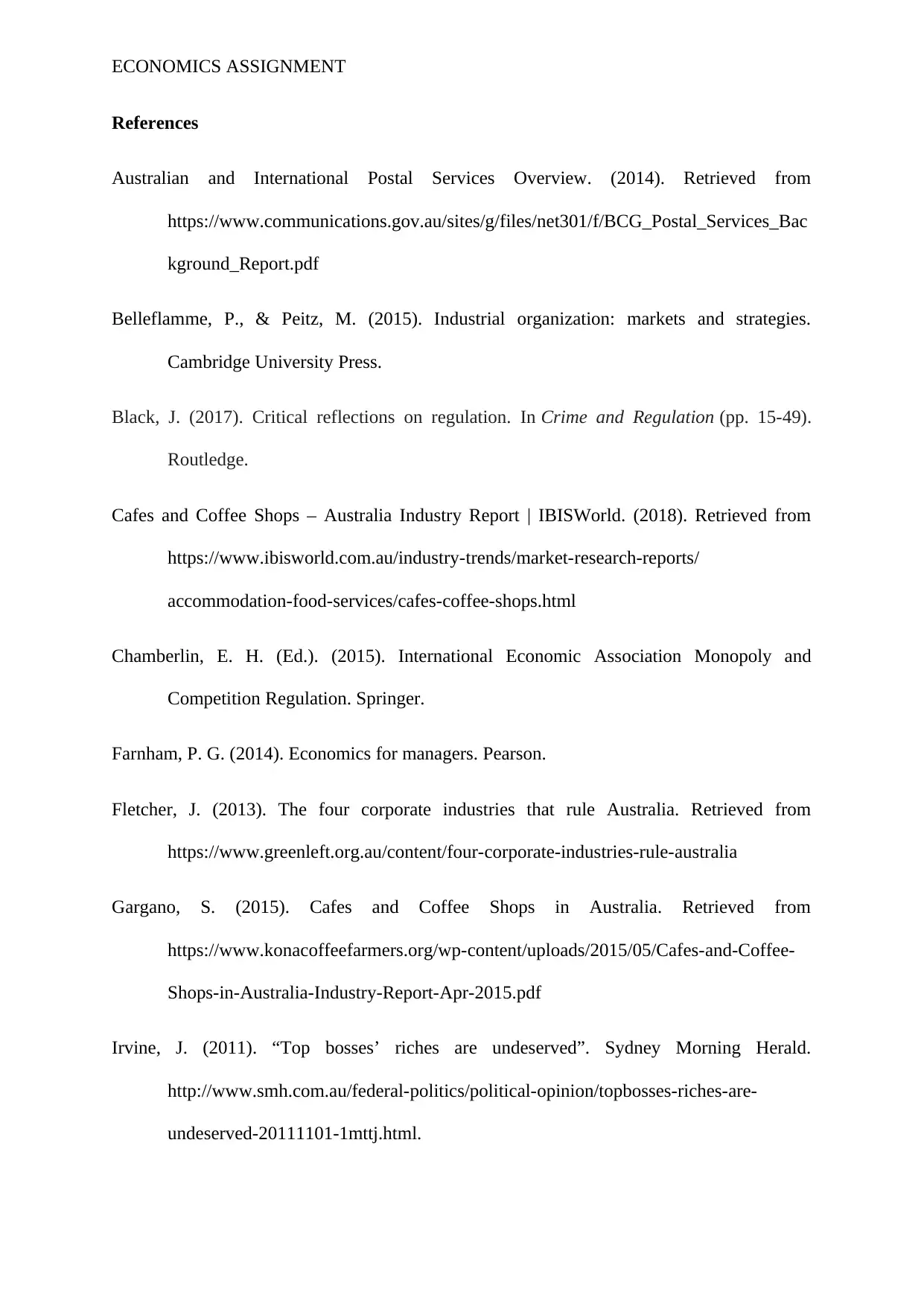
ECONOMICS ASSIGNMENT
References
Australian and International Postal Services Overview. (2014). Retrieved from
https://www.communications.gov.au/sites/g/files/net301/f/BCG_Postal_Services_Bac
kground_Report.pdf
Belleflamme, P., & Peitz, M. (2015). Industrial organization: markets and strategies.
Cambridge University Press.
Black, J. (2017). Critical reflections on regulation. In Crime and Regulation (pp. 15-49).
Routledge.
Cafes and Coffee Shops – Australia Industry Report | IBISWorld. (2018). Retrieved from
https://www.ibisworld.com.au/industry-trends/market-research-reports/
accommodation-food-services/cafes-coffee-shops.html
Chamberlin, E. H. (Ed.). (2015). International Economic Association Monopoly and
Competition Regulation. Springer.
Farnham, P. G. (2014). Economics for managers. Pearson.
Fletcher, J. (2013). The four corporate industries that rule Australia. Retrieved from
https://www.greenleft.org.au/content/four-corporate-industries-rule-australia
Gargano, S. (2015). Cafes and Coffee Shops in Australia. Retrieved from
https://www.konacoffeefarmers.org/wp-content/uploads/2015/05/Cafes-and-Coffee-
Shops-in-Australia-Industry-Report-Apr-2015.pdf
Irvine, J. (2011). “Top bosses’ riches are undeserved”. Sydney Morning Herald.
http://www.smh.com.au/federal-politics/political-opinion/topbosses-riches-are-
undeserved-20111101-1mttj.html.
References
Australian and International Postal Services Overview. (2014). Retrieved from
https://www.communications.gov.au/sites/g/files/net301/f/BCG_Postal_Services_Bac
kground_Report.pdf
Belleflamme, P., & Peitz, M. (2015). Industrial organization: markets and strategies.
Cambridge University Press.
Black, J. (2017). Critical reflections on regulation. In Crime and Regulation (pp. 15-49).
Routledge.
Cafes and Coffee Shops – Australia Industry Report | IBISWorld. (2018). Retrieved from
https://www.ibisworld.com.au/industry-trends/market-research-reports/
accommodation-food-services/cafes-coffee-shops.html
Chamberlin, E. H. (Ed.). (2015). International Economic Association Monopoly and
Competition Regulation. Springer.
Farnham, P. G. (2014). Economics for managers. Pearson.
Fletcher, J. (2013). The four corporate industries that rule Australia. Retrieved from
https://www.greenleft.org.au/content/four-corporate-industries-rule-australia
Gargano, S. (2015). Cafes and Coffee Shops in Australia. Retrieved from
https://www.konacoffeefarmers.org/wp-content/uploads/2015/05/Cafes-and-Coffee-
Shops-in-Australia-Industry-Report-Apr-2015.pdf
Irvine, J. (2011). “Top bosses’ riches are undeserved”. Sydney Morning Herald.
http://www.smh.com.au/federal-politics/political-opinion/topbosses-riches-are-
undeserved-20111101-1mttj.html.
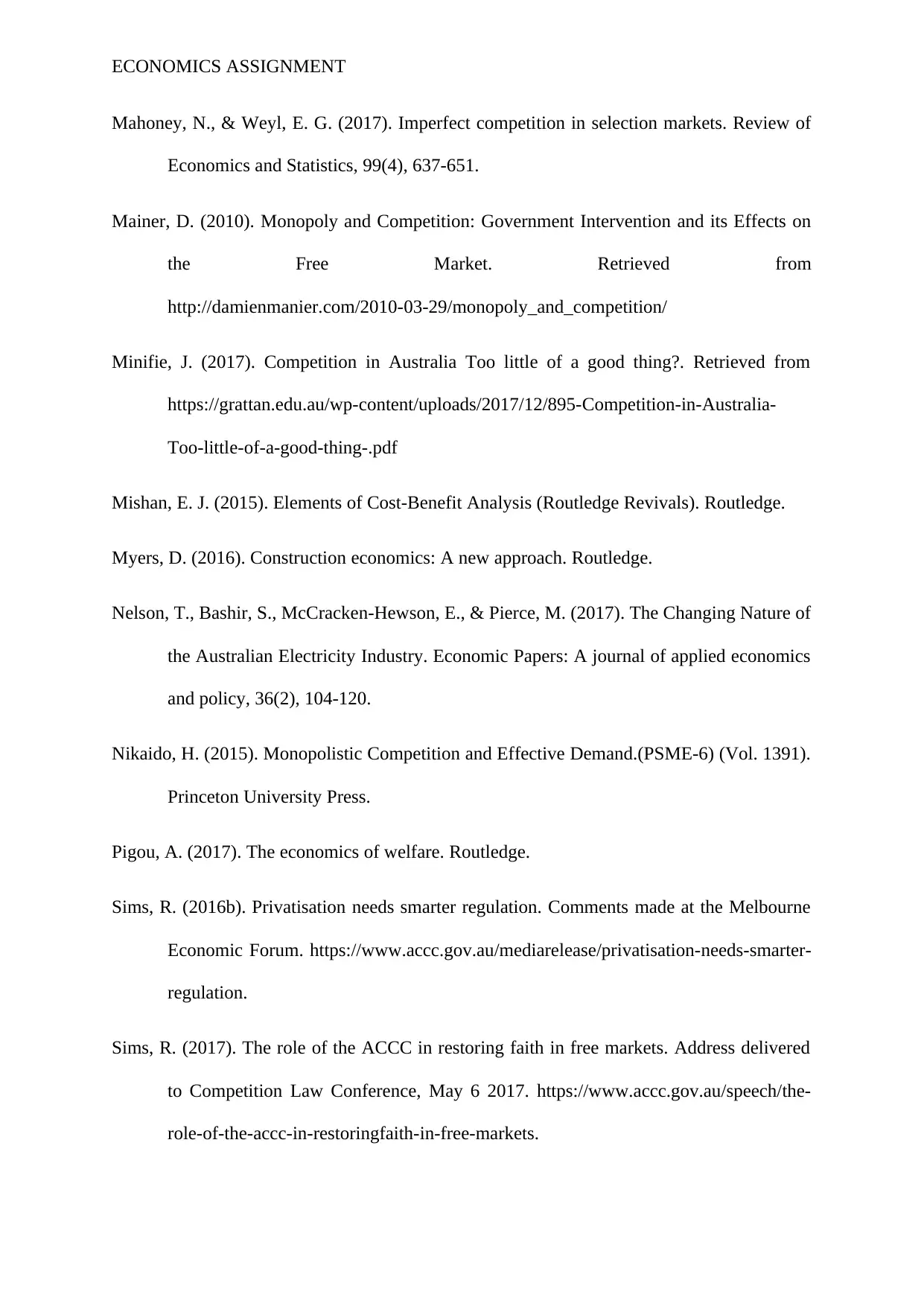
ECONOMICS ASSIGNMENT
Mahoney, N., & Weyl, E. G. (2017). Imperfect competition in selection markets. Review of
Economics and Statistics, 99(4), 637-651.
Mainer, D. (2010). Monopoly and Competition: Government Intervention and its Effects on
the Free Market. Retrieved from
http://damienmanier.com/2010-03-29/monopoly_and_competition/
Minifie, J. (2017). Competition in Australia Too little of a good thing?. Retrieved from
https://grattan.edu.au/wp-content/uploads/2017/12/895-Competition-in-Australia-
Too-little-of-a-good-thing-.pdf
Mishan, E. J. (2015). Elements of Cost-Benefit Analysis (Routledge Revivals). Routledge.
Myers, D. (2016). Construction economics: A new approach. Routledge.
Nelson, T., Bashir, S., McCracken‐Hewson, E., & Pierce, M. (2017). The Changing Nature of
the Australian Electricity Industry. Economic Papers: A journal of applied economics
and policy, 36(2), 104-120.
Nikaido, H. (2015). Monopolistic Competition and Effective Demand.(PSME-6) (Vol. 1391).
Princeton University Press.
Pigou, A. (2017). The economics of welfare. Routledge.
Sims, R. (2016b). Privatisation needs smarter regulation. Comments made at the Melbourne
Economic Forum. https://www.accc.gov.au/mediarelease/privatisation-needs-smarter-
regulation.
Sims, R. (2017). The role of the ACCC in restoring faith in free markets. Address delivered
to Competition Law Conference, May 6 2017. https://www.accc.gov.au/speech/the-
role-of-the-accc-in-restoringfaith-in-free-markets.
Mahoney, N., & Weyl, E. G. (2017). Imperfect competition in selection markets. Review of
Economics and Statistics, 99(4), 637-651.
Mainer, D. (2010). Monopoly and Competition: Government Intervention and its Effects on
the Free Market. Retrieved from
http://damienmanier.com/2010-03-29/monopoly_and_competition/
Minifie, J. (2017). Competition in Australia Too little of a good thing?. Retrieved from
https://grattan.edu.au/wp-content/uploads/2017/12/895-Competition-in-Australia-
Too-little-of-a-good-thing-.pdf
Mishan, E. J. (2015). Elements of Cost-Benefit Analysis (Routledge Revivals). Routledge.
Myers, D. (2016). Construction economics: A new approach. Routledge.
Nelson, T., Bashir, S., McCracken‐Hewson, E., & Pierce, M. (2017). The Changing Nature of
the Australian Electricity Industry. Economic Papers: A journal of applied economics
and policy, 36(2), 104-120.
Nikaido, H. (2015). Monopolistic Competition and Effective Demand.(PSME-6) (Vol. 1391).
Princeton University Press.
Pigou, A. (2017). The economics of welfare. Routledge.
Sims, R. (2016b). Privatisation needs smarter regulation. Comments made at the Melbourne
Economic Forum. https://www.accc.gov.au/mediarelease/privatisation-needs-smarter-
regulation.
Sims, R. (2017). The role of the ACCC in restoring faith in free markets. Address delivered
to Competition Law Conference, May 6 2017. https://www.accc.gov.au/speech/the-
role-of-the-accc-in-restoringfaith-in-free-markets.
Secure Best Marks with AI Grader
Need help grading? Try our AI Grader for instant feedback on your assignments.
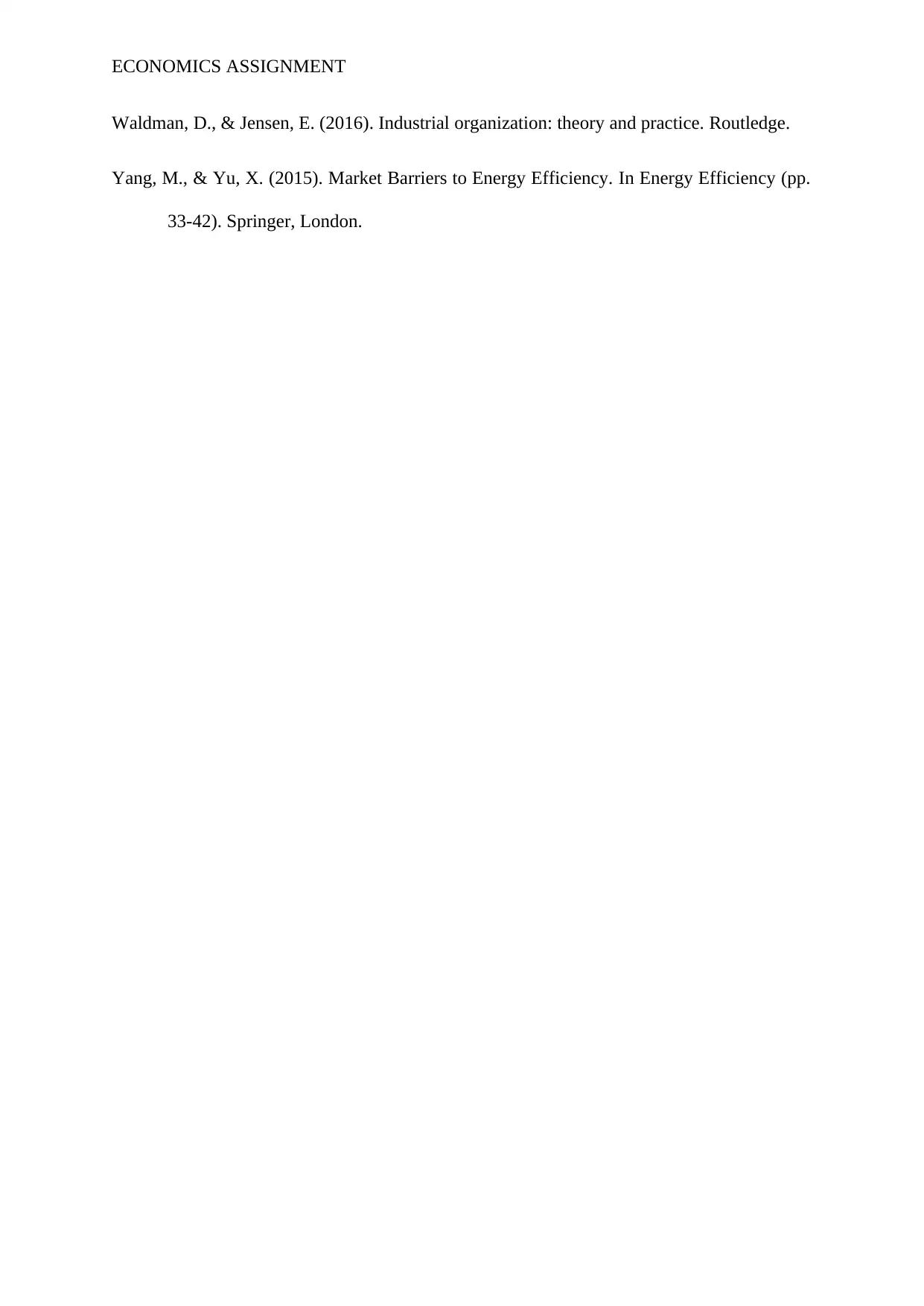
ECONOMICS ASSIGNMENT
Waldman, D., & Jensen, E. (2016). Industrial organization: theory and practice. Routledge.
Yang, M., & Yu, X. (2015). Market Barriers to Energy Efficiency. In Energy Efficiency (pp.
33-42). Springer, London.
Waldman, D., & Jensen, E. (2016). Industrial organization: theory and practice. Routledge.
Yang, M., & Yu, X. (2015). Market Barriers to Energy Efficiency. In Energy Efficiency (pp.
33-42). Springer, London.
1 out of 11
Related Documents
Your All-in-One AI-Powered Toolkit for Academic Success.
+13062052269
info@desklib.com
Available 24*7 on WhatsApp / Email
![[object Object]](/_next/static/media/star-bottom.7253800d.svg)
Unlock your academic potential
© 2024 | Zucol Services PVT LTD | All rights reserved.




